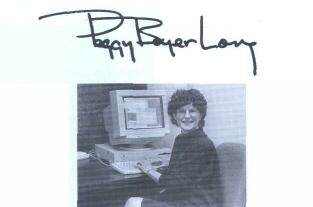 |
Home | Search | Browse | About IPO | Staff | Links |
 |
Home | Search | Browse | About IPO | Staff | Links |
|
EDITOR'S NOTEBOOK

The Little Theatre in Sullivan by Peggy Boyer Long It was such an improbable venture. And still is. When Guy S. Little Jr. opened the curtains on that first season in 1957 with, intriguing choice, a performance of Brigadoon, some citizens of the farm-country community of Sullivan thought he had gone out of his mind. And those were his friends. Though they may not have thought about it in quite this way, we can ask, with 40 years' hindsight, how that hometown boy could have imagined live professional theater would survive, let alone thrive, in a tiny, socially conservative east central Illinois town stuck, as some would say, midway between Chicago and St. Louis? For that matter, midway between New York and Los Angeles? Survive it has, though, through all but one "dark" season, into the era of cable television and into the age of the Internet. Still, the future of this smalltown Equity theater, one of only two in the central reaches of the state, remains anything but a sure bet. Over the years, The Little Theatre On The Square has earned its share of good reviews, for novelty at the least. In a star-studded heyday, when some of the biggest Broadway, Hollywood and soap opera actors of the time, Betty Grable and Pat O'Brien among them, were taking their turns on the boards at the playhouse across from the Moultrie County Courthouse, one big-city newspaper dubbed this theater in the cornfields "The Miracle of Sullivan." And, in 1996, the Illinois Arts Council designated it an Established Regional Arts Institution. But we're getting ahead of the story. Beth Conway Shervey, a scholar in American culture studies, has just written an oral history on the theater. The Little Theatre On The Square: Four Decades of a Small-Town Equity Theatre, published by Southern Illinois University Press, aims to explore the social consequences for a Midwestern town exposed earlier than comparable communities to, not merely the arts, but alternative lifestyles. Just as compelling, though, is the subtext, the story of the theater's own transformation, and its survival into a new century. Guy S. Little Jr. opened his theater, appropriately, on the site of what had been the Titus Opera House, an 1870s venue for touring theater and vaudeville companies. By the 1900s, that spot was used for movie houses, and Little began by renting the Grand Theatre for the summer. He later purchased the building. In 1959, his venture officially became a legitimate Equity theater, an extraordinary achievement for such a small town. It meant talent was more expensive, but the move also enabled him to attract major stars. And that turned out to be the theater's bread and butter in the early days. Those days ended, though, when the stars priced themselves out of smaller markets. After years of pumping family money into the business, Little leased the theater to a nonprofit group in 1979. Subsequently, a committed band of Sullivan citizens pulled together to keep the theater going. Today it's run by a regionwide board. The business of theater has changed nationwide in the past four decades, and, like so many arts institutions, the Little Theatre On The Square had to evolve just to keep the lights on. What once had been a profit-making enterprise that relied primarily on ticket sales has become a nonprofit institution that relies primarily on donations and grants, including some from the state. This little theater was reborn. And that, really, is the theme of our 5th annual arts issue. All over the state, we found creative people busy redefining art for a new century. Movie houses were recast, bringing new life to central cities. Small presses discovered new ways to reach readers on the Internet. We have many artists to thank for lending their talents to this effort, and to this issue, beginning with central Illinois painter Billy Morrow Jackson. His "Reading" appears on our cover. Public buildings throughout Illinois, including the state Capitol in Springfield, the Illinois School for the Deaf in Jacksonville and the Illinois Veterans Home in Quincy, display his works. Another painting will soon appear at the State Police district headquarters in Sterling. Go see this wonderful art. Will the arts survive into this next century? We have no doubts. 4 December 2000 Illinois Issues www.uis.edu/~ilissues |
|
|